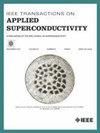约瑟夫森传输线中呼吸器产生的变频脉冲
IF 1.8
3区 物理与天体物理
Q3 ENGINEERING, ELECTRICAL & ELECTRONIC
引用次数: 0
摘要
单通量量子技术由于其低能耗、高速度和低温操作温度,具有增强超导量子系统读出和控制的潜力。目前的低温读出和控制通常需要特定频率的微波脉冲在室温控制电子设备和低温设置之间传播。通过在稀释制冷机内产生脉冲,可以改善控制和读出的延迟。在这项工作中,我们考虑了一种利用呼吸形成动力学,在没有室温合成或分流/偏置电阻的情况下,从约瑟夫森传输线中以直流为中心的磁通孤子和流体产生千兆赫频率微波音调的方案。仿真结果表明,在15.2 GHz ~ 21.5 GHz的频率范围内可以产生脉冲,最大能量效率为97%,带宽为40 MHz ~ 365 MHz。该协议也可用于产生千兆赫频率的高斯脉冲。我们详细介绍了与量子系统的控制和读出相关的指标,如输入功率、输出功率和占用空间。本文章由计算机程序翻译,如有差异,请以英文原文为准。
Variable Frequency Pulse Generation From Breathers in Josephson Transmission Lines
Single flux quantum technology has the potential to enhance readout and control of superconducting quantum systems due to their low energy consumption, high speed, and cryogenic operating temperatures. Current cryogenic readout and control typically requires microwave pulses of specific frequencies to travel between the room temperature control electronics and the cryogenic setup. Latency in control and readout can be improved by generating pulses within the dilution refrigerator. In this work, we consider a protocol for generating gigahertz frequency microwave tones from trains of dc-centered flux solitons and fluxoids in Josephson transmission lines using the dynamics of breather formation, without room temperature synthesis or shunt/bias resistors. Simulations show that pulses with frequencies in the range of 15.2 GHz to 21.5 GHz can be generated with maximal energy efficiency of 97% and bandwidth from 40 MHz to 365 MHz. This protocol can also be used to generate gigahertz frequency Gaussian pulses. We detail metrics relevant to the control and readout of quantum systems, such as input power, output power, and footprint.
求助全文
通过发布文献求助,成功后即可免费获取论文全文。
去求助
来源期刊

IEEE Transactions on Applied Superconductivity
工程技术-工程:电子与电气
CiteScore
3.50
自引率
33.30%
发文量
650
审稿时长
2.3 months
期刊介绍:
IEEE Transactions on Applied Superconductivity (TAS) contains articles on the applications of superconductivity and other relevant technology. Electronic applications include analog and digital circuits employing thin films and active devices such as Josephson junctions. Large scale applications include magnets for power applications such as motors and generators, for magnetic resonance, for accelerators, and cable applications such as power transmission.
 求助内容:
求助内容: 应助结果提醒方式:
应助结果提醒方式:


